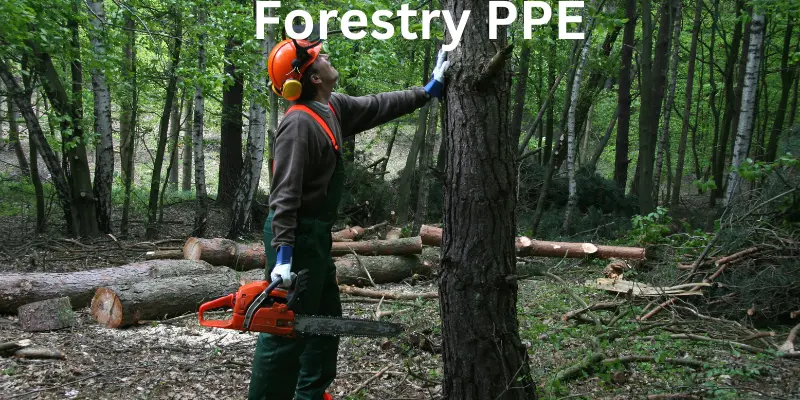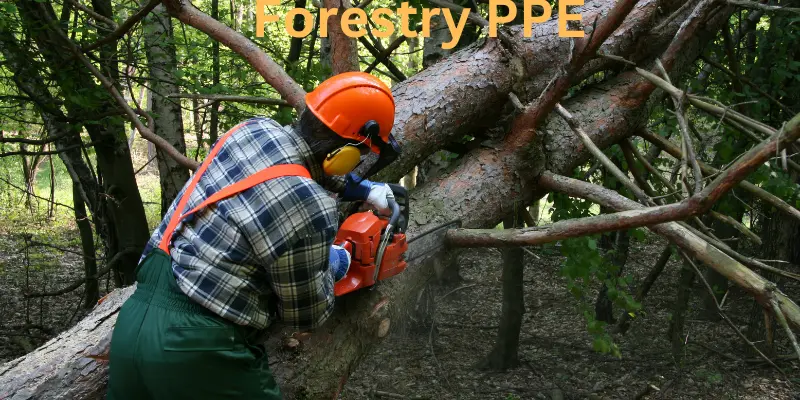Top 10 Forestry PPE and Manufacturers: A Comprehensive Guide
Updated: 19-Dec-2024
343
Personal Protective Equipment (PPE) refers to specialized clothing or gear designed to protect individuals from hazards in their work or environment. In industries like forestry, PPE serves as the frontline defense against injuries and accidents. Items such as helmets, gloves, goggles, boots, and ear protection are tailored to workers’ specific dangers.

1. Why Is PPE So Important for Us?
PPE is critical because it minimizes the risk of serious injuries and long-term health issues. In forestry, workers are exposed to sharp tools, heavy machinery, falling trees, and hazardous chemicals. Proper PPE ensures safety and enhances productivity by allowing workers to focus on their tasks without constant fear of accidents.
1. The Background of PPE
The concept of protective gear dates back centuries. Early forms of PPE included basic armor and shields used by soldiers. With industrialization, the need for safety equipment grew, especially in high-risk industries like mining, construction, and forestry. Over time, advancements in technology have led to the development of modern PPE, offering better protection and comfort.
2. Usage of PPE: Past, Present, and Future
- Past: In earlier times, PPE was rudimentary and limited to simple items like leather gloves and wooden helmets. These provided minimal protection and were often uncomfortable.
- Present: Today, PPE is highly advanced, incorporating materials like Kevlar, reinforced plastics, and breathable fabrics. Forestry workers now use helmets with visors, noise-canceling earmuffs, and chainsaw-resistant pants.
- Future: The future of PPE lies in smart technology. Wearable devices with sensors may monitor workers’ vitals, detect nearby hazards, and alert them in real time. Sustainable and eco-friendly PPE materials are also being explored.
2. Pros and Cons of PPE
Here’s the detail of benefits
Pros:
- Reduces workplace injuries.
- Enhances confidence and productivity.
- Protects against long-term health hazards.
- Complies with safety regulations.
- Improves worker morale.
- Available for various hazards.
- Adaptable for different climates.
- Encourages safety awareness.
- Affordable compared to medical costs.
- Improves emergency response readiness.
Cons:
- Can be uncomfortable during prolonged use.
- May limit mobility or dexterity.
- Requires regular maintenance.
- Initial costs can be high.
- Not foolproof; depends on correct usage.
- Can create a false sense of security.
- Might not fit all users perfectly.
- Needs periodic replacement.
- May not always be eco-friendly.
- Improper use can negate effectiveness.
3. What Is Forestry?
Forestry is the science and practice of managing forests to meet environmental, economic, and social needs. It involves planting, maintaining, and harvesting trees, as well as conserving biodiversity and ensuring sustainable use of forest resources.
1. Benefits of Forestry
- Environmental Protection: Reduces soil erosion and maintains water cycles.
- Climate Change Mitigation: Absorbs carbon dioxide, reducing greenhouse gases.
- Biodiversity Conservation: Provides habitats for wildlife.
- Economic Value: Supplies raw materials like timber and paper.
- Employment Opportunities: Creates jobs in rural areas.
- Recreation Spaces: Offers natural areas for tourism and leisure.
- Air Quality Improvement: Trees purify the air.
- Cultural Importance: Supports indigenous practices and traditions.
- Renewable Resource: Ensures sustainable material use.
- Flood Prevention: Helps in managing water flow.
4. 10 leading forestry PPE manufacturing companies:
Protective equipment is crucial in forestry to protect workers from potential hazards. These companies are recognized for their commitment to safety and quality and provide essential PPE to protect forestry workers worldwide.
1. STIHL
Founded in 1926, STIHL is headquartered at Badstrasse 115, 71336 Waiblingen, Germany. With a global workforce of over 20,000 employees, STIHL is renowned for producing high-quality outdoor power equipment and comprehensive protective gear for forestry professionals.
1. Forestry PPE products:
- Chainsaw protective pants
- Forestry helmets with visors
- Protective gloves
- Hearing protection earmuffs
- Safety boots
- Cut-resistant jackets
- Face shields
- High-visibility vests
- Protective eyewear
- Chainsaw chaps
2. Husqvarna
Established in 1689, Husqvarna’s headquarters are located at Drottninggatan 2, 561 82 Huskvarna, Sweden. Employing around 13,000 people, Husqvarna offers a wide range of products, including forestry PPE designed to ensure safety and efficiency for professionals.
1. Forestry PPE products:
- Chainsaw protective trousers
- Forestry helmets with hearing protection
- Protective gloves
- Safety boots
- Protective jackets
- Face shields
- High-visibility clothing
- Protective eyewear
- Chainsaw chaps
- Hearing protection earmuffs
3. 3M Company
Founded in 1902, 3M is headquartered at 3M Center, St. Paul, Minnesota, USA. With approximately 95,000 employees worldwide, 3M provides innovative safety solutions, including PPE suitable for forestry applications.
1. Forestry PPE products:
- Safety helmets
- Hearing protection earmuffs
- Protective eyewear
- Respirators
- Reflective vests
- Protective gloves
- Face shields
- Safety harnesses
- Chainsaw chaps
- Protective coveralls
4. Pfanner Schutzbekleidung GmbH
Established in 1990, Pfanner is based at Lauterachstraße 38, 6923 Lauterach, Austria. With a dedicated team, Pfanner specializes in high-quality protective clothing and equipment for forestry workers, emphasizing comfort and safety.
1. Forestry PPE products:
- Chainsaw protective trousers
- Protective jackets
- Safety helmets with visors
- Hearing protection
- Protective gloves
- Safety boots
- High-visibility clothing
- Cut-resistant shirts
- Face shields
- Chainsaw chaps
5. Protos Integral
Protos Integral, a brand under Pfanner, focuses on innovative head protection systems for forestry and other industries. Their products are designed to offer maximum safety and comfort for professionals.
1. Forestry PPE products:
- Integral safety helmets
- Hearing protection modules
- Integrated face shields
- Ventilation systems for helmets
- Neck protection accessories
- Helmet lighting systems
- Communication systems for helmets
- Protective eyewear
- Helmet rain protection
- Chin straps
6. Oregon Tool, Inc.
Founded in 1947, Oregon Tool is headquartered at 4909 SE International Way, Portland, Oregon, USA. With a substantial workforce, the company is a leading manufacturer of saw chains and other equipment, providing essential PPE for forestry professionals.
1. Forestry PPE products:
- Chainsaw protective chaps
- Protective gloves
- Safety helmets with face shields
- Hearing protection earmuffs
- Protective eyewear
- Safety boots
- High-visibility vests
- Protective jackets
- Chainsaw protective trousers
- Face shields
7. Uvex Safety Group
Established in 1926, Uvex is headquartered at Würzburger Str. 154, 90766 Fürth, Germany. Operating in over 60 countries, Uvex manufactures a wide range of PPE products, including those suitable for forestry applications.
1. Forestry PPE products:
- Safety helmets
- Protective eyewear
- Hearing protection
- Protective gloves
- Face shields
- Safety boots
- High-visibility clothing
- Respiratory protection
- Chainsaw chaps
- Protective coveralls
8. MSA Safety Incorporated
Founded in 1914, MSA Safety is headquartered at 1000 Cranberry Woods Drive, Cranberry Township, Pennsylvania, USA. With approximately 4,800 employees, MSA specializes in developing safety products that protect workers in hazardous environments, including forestry.
1. Forestry PPE products:
- Safety helmets
- Hearing protection
- Protective eyewear
- Face shields
- Respiratory protection
- Protective gloves
- Safety boots
- High-visibility vests
- Fall protection equipment
- Chainsaw chaps
9. Petzl
Established in 1975, Petzl is headquartered at Boulevard de l’Europe, 38920 Crolles, France. With a focus on designing equipment for verticality and lighting, Petzl provides PPE solutions applicable to forestry operations.
1. Forestry PPE products:
- Safety helmets
- Headlamps
- Harnesses
- Lanyards
- Carabiners
- Ascenders
- Descenders
- Protective gloves
- Rope clamps
- Fall arrest systems
10. Rock Fall (UK) Ltd.
Founded in 1997, Rock Fall is headquartered at Wimsey Way, Alfreton, Derbyshire, UK. As a manufacturer of specialist safety footwear, Rock Fall offers products suitable for forestry professionals, ensuring protection and comfort.
1. Forestry PPE products:
- Chainsaw protective boots
- Waterproof safety boots
- Slip-resistant footwear
- Steel-toe cap boots
- Electrical hazard protection boots
- Lightweight safety trainers
- Metatarsal protection boots
- Anti-static footwear
- Heat-resistant boots
- Insulated safety boots

5. FAQs About Forestry PPE
- What is forestry PPE?
Forestry PPE includes safety gear like helmets, gloves, goggles, and boots designed for forestry workers. - Why is forestry PPE essential?
It protects workers from injuries caused by falling trees, sharp tools, and loud machinery. - What materials are used in forestry PPE?
Common materials include Kevlar, polycarbonate, and durable rubber. - How should PPE be maintained?
Clean it regularly, check for damages, and replace worn-out items. - Can forestry PPE be reused?
Yes, but only if it’s in good condition and has not been compromised during use. - What are the legal requirements for PPE in forestry?
Regulations vary by country but generally mandate appropriate safety gear for workers. - Is all forestry PPE the same?
No, PPE varies depending on the specific hazards of the job. - What is the cost of forestry PPE?
Costs range widely depending on the type and quality of equipment. - How often should forestry PPE be replaced?
It should be replaced as soon as it shows signs of wear or damage. - What is the role of technology in forestry PPE?
Innovations like smart helmets and sensor-equipped clothing enhance safety and functionality.
6. Conclusion
Forestry PPE protects workers and is indispensable for ensuring the safety and well-being of workers in this demanding industry. While there are some drawbacks, the benefits far outweigh them. As technology advances, forestry PPE will become even more effective and sustainable, supporting safer and more productive forestry practices. By prioritizing safety through proper use of PPE, we protect workers and contribute to a more sustainable future.
Please Write Your Comments